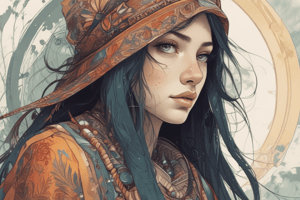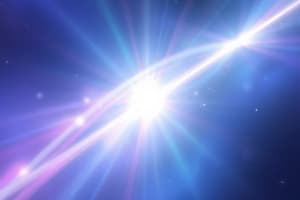Podcast
Questions and Answers
What object is used to split white light in the experiment?
What object is used to split white light in the experiment?
A glass prism
How does white light behave when it enters and exits the glass prism?
How does white light behave when it enters and exits the glass prism?
It exits as a spectrum of colors.
What is the name of the process that separates white light into colors in the experiment?
What is the name of the process that separates white light into colors in the experiment?
Dispersion
What should you avoid doing with a laser pointer to ensure safety?
What should you avoid doing with a laser pointer to ensure safety?
What did Isaac Newton discover about white light in 1666?
What did Isaac Newton discover about white light in 1666?
What is the range of colours that can be seen in white light called?
What is the range of colours that can be seen in white light called?
Describe one method to create a rainbow at home.
Describe one method to create a rainbow at home.
How many colours are generally agreed to be in the spectrum of white light?
How many colours are generally agreed to be in the spectrum of white light?
Which colors are visible in the spectrum shown on the screen behind the prism?
Which colors are visible in the spectrum shown on the screen behind the prism?
List the seven colours of the spectrum in order.
List the seven colours of the spectrum in order.
What phenomenon explains the splitting of white light into different colours?
What phenomenon explains the splitting of white light into different colours?
What shape of glass block did Newton use to split the light?
What shape of glass block did Newton use to split the light?
Which colour of light is refracted through the largest angle in a prism?
Which colour of light is refracted through the largest angle in a prism?
Which colour of light is refracted through the smallest angle in a prism?
Which colour of light is refracted through the smallest angle in a prism?
What happens to the colours of light that do not pass through a coloured filter?
What happens to the colours of light that do not pass through a coloured filter?
What colour of light does a red filter transmit?
What colour of light does a red filter transmit?
How many colours are in white light?
How many colours are in white light?
What principle do traffic lights use to display different colours?
What principle do traffic lights use to display different colours?
What color is the lamp in the stage light?
What color is the lamp in the stage light?
What would you observe if a green filter was placed in front of a white light source?
What would you observe if a green filter was placed in front of a white light source?
Which colours are subtracted from white light to produce red light using a red filter?
Which colours are subtracted from white light to produce red light using a red filter?
Why do photographers use coloured filters on their cameras?
Why do photographers use coloured filters on their cameras?
Why is the flower seen in yellow?
Why is the flower seen in yellow?
What colors of light does a white object reflect?
What colors of light does a white object reflect?
What happens to light when it hits a black object?
What happens to light when it hits a black object?
Why do we see a flower as yellow in color?
Why do we see a flower as yellow in color?
What color does a black object reflect?
What color does a black object reflect?
Why does a red object appear red to us?
Why does a red object appear red to us?
What happens to the colors that are not reflected by an object?
What happens to the colors that are not reflected by an object?
If an object absorbs all colors of light, what color will it appear?
If an object absorbs all colors of light, what color will it appear?
What are the three primary colours of light?
What are the three primary colours of light?
What colour is produced when red and green light are combined?
What colour is produced when red and green light are combined?
What colour results from mixing red and blue light?
What colour results from mixing red and blue light?
What happens when you combine red, green, and blue light?
What happens when you combine red, green, and blue light?
What are the seven colours that make up white light?
What are the seven colours that make up white light?
How do primary colours in light differ from primary colours in paint?
How do primary colours in light differ from primary colours in paint?
By placing a red filter in front of a white light source, which colour will be transmitted?
By placing a red filter in front of a white light source, which colour will be transmitted?
What colour is produced by mixing blue and green light?
What colour is produced by mixing blue and green light?
List the three primary colours of light.
List the three primary colours of light.
Name the colour produced when red light and green light are added together, and when red, green, and blue lights are added together.
Name the colour produced when red light and green light are added together, and when red, green, and blue lights are added together.
A stage light uses a shine lamp. What colour of light will be seen when a yellow filter is used?
A stage light uses a shine lamp. What colour of light will be seen when a yellow filter is used?
A stage light uses a shine lamp. What colour of light will be seen when an orange filter is used?
A stage light uses a shine lamp. What colour of light will be seen when an orange filter is used?
A green hall appears green. What two colours of lights could be shining on the green hall?
A green hall appears green. What two colours of lights could be shining on the green hall?
A blue hall appears black. What two colours of light could be shining on the blue hall?
A blue hall appears black. What two colours of light could be shining on the blue hall?
A T-shirt looks red. What explain this?
A T-shirt looks red. What explain this?
Identify the primary colours needed to create the following colours: cyan, magenta, yellow.
Identify the primary colours needed to create the following colours: cyan, magenta, yellow.
How many stars are estimated to be in the Milky Way galaxy?
How many stars are estimated to be in the Milky Way galaxy?
What is the definition of the Universe?
What is the definition of the Universe?
What shape is the Milky Way galaxy?
What shape is the Milky Way galaxy?
Why do most of the stars we see at night belong to the Milky Way?
Why do most of the stars we see at night belong to the Milky Way?
What looks like a white band across the sky from Earth?
What looks like a white band across the sky from Earth?
What are galaxies made of?
What are galaxies made of?
What are the different shapes of galaxies?
What are the different shapes of galaxies?
What force holds the parts of a galaxy together?
What force holds the parts of a galaxy together?
Where do most of the stars we see in the night sky come from?
Where do most of the stars we see in the night sky come from?
Why can scientists only estimate the number of stars in the Milky Way?
Why can scientists only estimate the number of stars in the Milky Way?
Where are the majority of asteroids found?
Where are the majority of asteroids found?
What is the shape of a typical asteroid?
What is the shape of a typical asteroid?
What clues do asteroids provide about the Solar System?
What clues do asteroids provide about the Solar System?
Which is the largest asteroid and what is it considered?
Which is the largest asteroid and what is it considered?
What threat do smaller asteroids pose to Earth?
What threat do smaller asteroids pose to Earth?
What have some studied asteroids been found to contain?
What have some studied asteroids been found to contain?
Flashcards are hidden until you start studying
Study Notes
Newton's Discovery about Light
- In 1666, Isaac Newton made a significant discovery about light, splitting it into different colors using a triangular prism.
- White light can be split into a range of colors, known as a spectrum, which includes red, orange, yellow, green, blue, indigo, and violet.
Dispersion
- Dispersion is the process of splitting light into different colors, which occurs because light is refracted at slightly different angles.
- This can be demonstrated using a triangular prism, where violet light is refracted at the largest angle and red light at the smallest angle.
The Experiment
- A glass prism is used to split white light into its different colors, which are then projected onto a screen.
- The prism separates white light into seven colors: red, orange, yellow, green, blue, indigo, and violet.
Primary Colours of Light
- There are three primary colours of light: red, blue, and green, which cannot be made by mixing other colors of light.
- These primary colours can be combined to produce other colors, such as yellow (red + green), magenta (red + blue), and cyan (blue + green).
Subtracting Colours of Light
- Coloured filters can be used to subtract certain colours of light, allowing only specific colours to pass through.
- For example, a red filter absorbs all colours except red, while a yellow filter absorbs all colours except yellow.
Seeing Colour
- Objects appear in different colours because they reflect certain wavelengths of light and absorb others.
- For example, a yellow flower reflects yellow light and absorbs other colours, while a black object absorbs all colours and reflects none.
Light
- Light is made up of different colours, which can be separated using a prism or combined to produce different colours and shades.
- Different colours of light can be produced by using filters or by shining light through coloured objects.
Galaxies
- The Milky Way is a spiral galaxy, consisting of an estimated 250,000,000 stars, including the Sun.
- There are different shapes of galaxies, including spiral, elliptical, and irregular galaxies.
Asteroids
- Asteroids are rocky fragments that orbit the Sun, found primarily between Mars and Jupiter.
- They provide clues about the early history of the Solar System and can have irregular shapes due to collisions with other celestial bodies.
Studying That Suits You
Use AI to generate personalized quizzes and flashcards to suit your learning preferences.




